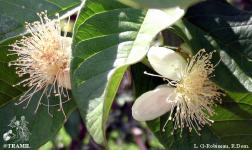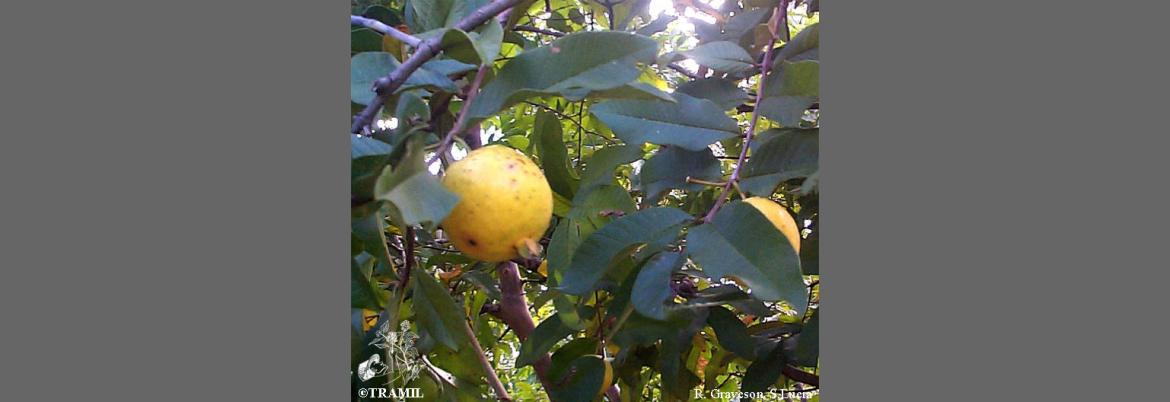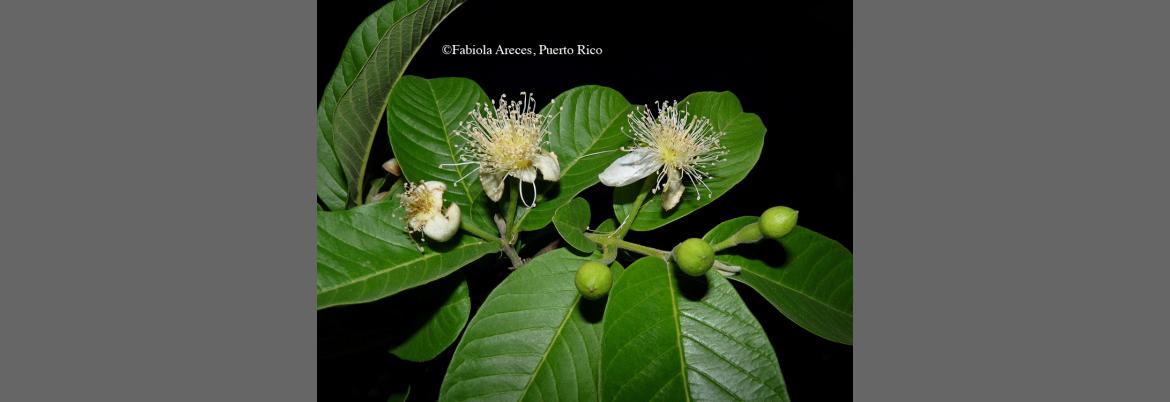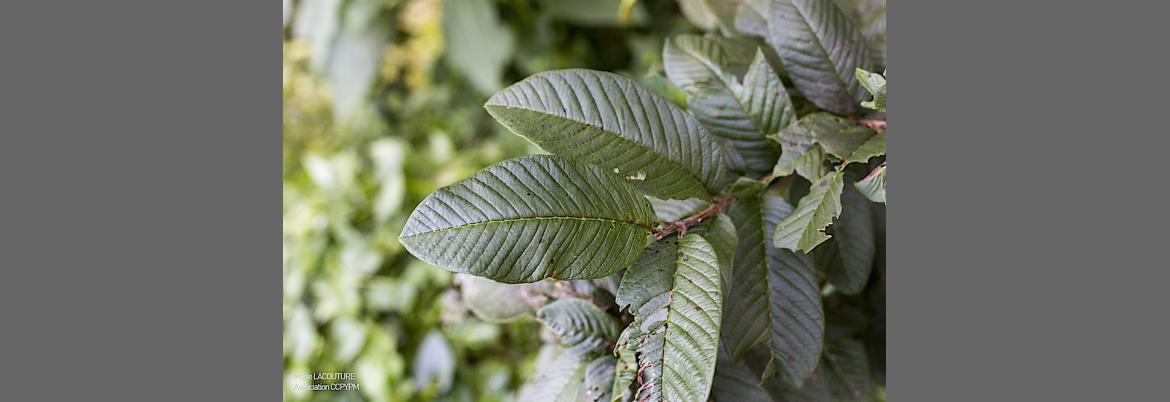1 GERMOSEN-ROBINEAU L, GERONIMO M, AMPARO C, 1984 Encuesta TRAMIL. enda-caribe, Santo Domingo, Rep. Dominicana.
2 WENIGER B, 1987-88 Encuesta TRAMIL. enda-caribe, Santo Domingo, Rep. Dominicana.
3 HERRERA J, 1994 Encuesta TRAMIL (Costa atlántica). Laboratorio de fitofarmacología, Departamento de Farmacología, Facultad de Salud, Universidad del Valle, Cali, Colombia.
4 CHARLES C, 1988 TRAMIL survey. Movement for Cultural Awareness MCA, Roseau, Dominica.
5 EDOUARD JA, 1992 Enquête TRAMIL. Lycée agricole, Baie-Mahault, Guadeloupe.
6 GIRON L, 1988 Encuesta TRAMIL (Costa atlántica). Centro Mesoamericano de Tecnología CEMAT, Guatemala, Guatemala.
7 WENIGER B, ROUZIER M, 1986 Enquête TRAMIL. Service Oecuménique d'Entraide SOE, Port au Prince, Haïti.
8 LONGUEFOSSE JL, NOSSIN E, 1990-95 Enquête TRAMIL. Association pour la valorisation des plantes médicinales de la Caraïbe AVPMC, Fort de France, Martinique.
9 DELENS M, 1990-92 Encuesta TRAMIL. Centro al Servicio de la Acción Popular CESAP, Caracas, Venezuela.
10 MARCELLE G, 1996 TRAMIL survey. Produce chemist laboratory, Ministry of Agriculture, St George's, Grenada.
11 MENDEZ M, MEDINA ML, DURAN R, 1996 Encuesta TRAMIL. Unidad de recursos naturales, Centro de Investigación Científica de Yucatán CICY, Mérida, México.
12 SolIs PN, Espinosa A, De Gracia J, MartInez L, Gupta MP, 2003 Encuesta TRAMIL (Emberá-Wounaann). Centro de Investigaciones Farmacognósticas de la Flora Panameña, Facultad de Farmacia, Universidad de Panamá, Panamá, Panamá.
13 WHO, 1991 Pautas para la evaluación de medicamentos herbarios WHO/TRM/91.4 (original inglés). Programa de Medicina Tradicional, OMS, Ginebra, Suiza.
14 Solis PN, Olmedo D, Buitrago de Tello RE, Gupta MP, 2000 Estudio fitoquímico y toxicológico de algunas plantas TRAMIL. Informe TRAMIL. Centro de Investigaciones Farmacognósticas de la Flora Panameña CIFLORPAN, Facultad de Farmacia, Universidad de Panamá, Panamá, Panamá.
15 WILSON CW, SHAW PE, 1978 Terpene hydrocarbons from Psidium guajava. Phytochemistry 17:1435-1436.
16 MACLEOD AJ, DE TROCONIS NG, 1982 Volatile flavour components of guava. Phytochemistry 21(6):1339-1342.
17 MISRA K, SESHADRI TR, 1968 Chemical components of the fruits of Psidium guajava. Phytochemistry 7:641-645.
18 CHIANG H, LEE S, GUO S, 1986 Active principles of hypoglycemic effect from Psidium guajava. Part II. Asian J Pharm Suppl 6(8):58.
19 VARSHNEY I, BADHWAR G, KHAN A, SHRIVASTAVA A, 1971 Saponins and sapogenins of Sesbania grandiflora seeds, Albizzia lebbek pods and Psidium guajava fruits. Indian J Appl Chem 34:214.
20 BASSOLS F, DEMOLE EP, 1994 The occurrence of pentane-2-thiol in guava fruit. J Essent Oil Res 6(5):481-483.
21 DAVIS P, MUNROE K, SELHIME A, 1976 Laboratory Proc Fla State Hort Soc bioassay of volatile naturally occurring compounds against the Caribbean fruit fly. p174.
22 LOWRY JB, 1968 The distribution and potential taxonomic value of alkylated ellagic acids. Phytochemistry 7(10):1803-1813.
23 MAIR AGR, PANDIYAN M, VENKASUBRAMANIAN H, 1987 Polyphenolic compounds from flowers of Psidium guajava. Fitoterapia 58(3):204-205.
24 SESHADRI TR, VASISHTA K, 1965 Polyphenols of the leaves of Psidium guava-quercetin, guaijaverin, leucocyanidin and amritoside. Phytochemistry 4:989-992.
25 GRIFFITHS LA, 1959 On the distribution of gentisic acid in green plants. J Exp Biol 10:437-442.
26 KAKIUCHI N, HATTORI M, NAMBA T, NISHIZAWA M, YAMAGISHI T, OKUDA T, 1985 Inhibitory effect of tannins on reverse transcriptase from RNA tumor virus. J Nat Prod 48(4):614-621.
27 LOZOYA X, MECKES M, ABOU-AAID M, TORTORIELLO J, NOZZOLILLO C, ARNASON J, 1994 Quercetin glycosides in Psidium guajava L. leaves and determination of a spasmolytic principle. Arch Med Res 25(1):11-15.
28 OKUDA T, HATANO T, YAZAKI K, 1984 Guavin B, an ellagitannin of novel type. Chem Pharm Bull 32(9):3787-3788.
29 LUTTERODT GD, 1989 Inhibition of gastrointestinal release of acetylcholine by quercetin as a possible mode of action of Psidium guajava leaf extracts in the treatment of acute diarrhoeal disease. J Ethnopharmacol 25(3):235-247.
30 OKUDA T, YOSHIDA T, HATANO T, YAZAKI K, ASHIDA M, 1982 Tannins and related compounds in Myrtaceae. Ellagitannins of the Casuarinaceae, Stachyuraceae and Myrtaceae. Phytochemistry 21:2871-2874.
31 OKUDA T, YOSHIDA T, HATANO T, YAZAKI K, IKEGAMI Y, SHINGU T, 1987 Guavins A, C and D, complex tannins from Psidium guajava. Chem Pharm Bull 35(1):443-446.
32 OSMAN AM, YOUNES ME, SHETA AE, 1974 Triterpenoids of the leaves ofPsidium guajava. Phytochemistry 13:2015-2016.
33 OSMAN A, EL-GARBY Y, SHETA A, 1975 Chemical examination of local plants part. VII. Psidium guajava leaf extracts. Egypt J Chem 18:347.
34 SESHADRI TR, VASISHTA K, 1965 Polyphenols of the stem bark of Psidium guajava, the constitution of a new ellagic acid glycoside (amritoside). Phytochemistry 4:317-326
35 TANAKA T, ISHIDA N, ISHIMATSU M, NONAKA G, NISHIOKA I, 1992 Tannins and related compounds. CXVI. Six new complex tannins, guajavins, psidinins and psiguavin from the bark of Psidium guajava L. Chem Pharm Bull 40(8):2092-2098.
36 MISHRA C, MISRA K, 1981 Chemical constituents of Psidium guajava heartwood. J Indian Chem Soc 58:201-202.
37 SASAKI S, CHIANG HC, HABAGUCHI K, YAMADA T, NAKANISHI K, MATSUEDA S, HSU H, WU W, 1966 The constituents of medicinal plants in Taiwan. Yakugaku Zasshi 86(9):869-870.
38 TRIVEDI KK, MISRA K, 1984 Chemical investigation of Psidium guajava roots. Curr Sci 53(14):746-747.
39 DUKE JA, ATCHLEY AA, 1986 Handbook of proximate analysis tables of higher plants. Boca Raton, USA: CRC Press. p136.
40 ECHEMENDIA C, MORON F, 1997 Efecto antidiarreico de la tintura al 20% de hojas de Psidium guajava (guayaba), en pacientes con diarrea aguda simple en atención primaria de salud. Informe TRAMIL. Laboratorio Central de Farmacología, Facultad de Ciencias Médicas “Dr. Salvador Allende”, La Habana, Cuba.
41 ECHEMENDIA C, 1997 Efecto antidiarreico de la tintura al 20% de hojas de Psidium guajava (guayaba), en pacientes con diarrea aguda simple en atención primaria de salud (Tesis de Maestría). Universidad Médica de La Habana, La Habana, Cuba.
42 GUPTA M, ESPOSITO AVELLA M, 1988 Evaluación química y farmacológica de algunas plantas medicinales de TRAMIL. Centro de Investigaciones Farmacognósticas de la Flora Panameña CIFLORPAN, Facultad de Farmacia, Universidad de Panamá, Panamá, Panamá.
43 MARTINEZ MJ, BETANCOURT J, LOPEZ M, MOREJON Z, BOUCOURT E, MORON F, 2000 Actividad antimicrobiana in vitro de hoja de Psidium guajava L. Informe TRAMIL. Laboratorio Central de Farmacología, Facultad de Ciencias Médicas “Dr. Salvador Allende”, La Habana, Cuba.
44 MORON F, MARTINEZ MC, MORON D, 1999 Disminución del tránsito intestinal en ratones por tintura de guayaba (Psidium guajava L.) oral. Rev Cubana Planta Med 4(2):54-56.
45 MISA C, HERNANDEZ N, ABRAHAM A, 1979 Contribution to the biological evaluation of Cuban plants. I. Rev Cubana Med Trop 31:5-12.
46 CACERES A, JAUREGUI E, HERRERA D, LOGEMANN H, 1991 Plants used in Guatemala for the treatment of dermatomucosal infections. 1: Screening of 38 plant extracts for anticandidal activity. J Ethnopharmacol 33(3):277-283.
47 GNAN SO, DEMELLO MT, 1999 Inhibition of Staphylococcus aureus by aqueous goiaba extracts. J Ethnopharmacology 68(1-3):103-108.
48 CACERES A, TORRES MF, ORTIZ S, CANO F, JAUREGUI E, 1993 Plants used in Guatemala for the treatment of gastrointestinal disorders. IV. Vibriocidal activity of five American plants used to treat infections. J Ethnopharmacol 39(1):73-75.
49 LOZOYA X, BECERRIL G, MARTINEZ M, 1990 Intraluminal perfusion model of in vitro guinea pig ileum as a model of study of the antidiarrheic properties of guava (Psidium guajava). Arch Invest Med (Mex) 21:155-162.
50 CHENG JT, YANG RS, 1983 Hypoglycemic effect of Guava juice in mice and human subjects. Am J Chin Med 11(1-4):74-76.
51 LUTTERODT G, 1992 Inhibition of microlax-induced experimental diarrhea with narcotic-like extracts of Psidium guajava leaf in rats. J Ethnopharmacol 37(2):151-157.
52 LOZOYA X, REYES-MORALES H, CHAVEZ-SOTO MA, MARTINEZ-GARCIA MC, SOTO-GONZALEZ Y, DOUBOVA SV, 2002 Intestinal anti-spasmodic effect of a phytodrug of Psidium guajava folia in the treatment of acute diarrheic disease. J Ethnopharmacol 83:19-24.
53 MARTINEZ MJ, BETANCOURT J, LOPEZ M, MOREJON Z, BOUCOURT E, MORON F, 2000 Actividad genotóxica in vitro de hoja de Psidium guajava L. Informe TRAMIL. Laboratorio Central de Farmacología, Facultad de Ciencias Médicas “Dr. Salvador Allende”, La Habana, Cuba.
54 BETANCOURT J, RAMOS A, VIZOSO A, MARTÍNEZ MJ, LOPEZ M, 2000 Ausencia de actividad genotóxica del extracto fluido de Psidium guajava L (guayaba) evaluada en un sistema de ensayo de Aspergillus nidulans. Rev Cubana Planta Med 5(2):38-40.
55 MARTINEZ MJ, BETANCOURT J, LOPEZ M, MOREJON Z, BOUCOURT E, MORON F, 2000 Actividad genotóxica in vivo de hoja de Psidium guajava L. Informe TRAMIL. Laboratorio Central de Farmacología, Facultad de Ciencias Médicas “Dr. Salvador Allende”, La Habana, Cuba.
56 MARTINEZ MJ, BETANCOURT J, LOPEZ M, MOREJON Z, BARCELO H, LAINEZ A, MONTES ME, REGO R, BOUCOURT E, MORON F, 2000 Toxicidad aguda clásica de hoja de Psidium guajava L. Informe TRAMIL. Laboratorio Central de Farmacología, Facultad de Ciencias Médicas “Dr. Salvador Allende”, La Habana, Cuba.
57 MARTINEZ MJ, BETANCOURT J, LOPEZ M, MOREJON Z, BARCELO H, LAINEZ A, MONTES ME, REGO R, BOUCOURT E, MORON F, 2000 Toxicidad aguda de hoja de Psidium guajava L. en el modelo de clases tóxicas agudas. Informe TRAMIL. Laboratorio Central de Farmacología, Facultad de Ciencias Médicas “Dr. Salvador Allende”, La Habana, Cuba.
58 JAIN AK, SHIMOI K, NAKAMURA Y, TOMITA I, KADA T, 1987 Preliminary study on the desmutagenic and antimutagenic effect of some natural products. Curr Sci 56(24):1266-1269.
59 GIRON L, CACERES A, FREIRE V, ALONZO A, SALVADOR L, 1995 Folleto informativo sobre algunas plantas medicinales comúnmente utilizadas por la población Garífuna de Livingston. Guatemala, Guatemala: Programa TRAMIL-Centroamérica/enda-caribe/CONAPLAMED/FARMAYA/CIID. p26.
60 DELAIGUE J, 2005 TRAMIL survey. PRDI, Tobago House of Assembly, Scarborough, Tobago.
61 PAZOS L, COTO T, GONZALEZ S, 2006 Toxicidad oral aguda dosis repetida, en ratón, del extracto de la corteza fresca de Psidium guajava. Informe TRAMIL. Laboratorio de Ensayos Biológicos, LEBi, Universidad de Costa Rica, San Pedro, Costa Rica.
62 MARTINEZ M, HERNANDEZ O, HERNANDEZ J, SARMIENTO E, 2003 Encuesta TRAMIL-GEF Guajiquiro, La Paz. Laboratorio de Histolología Vegetal y Etnobotánica, Dep. de Biología, Universidad Nacional Autónoma de Honduras UNAH, Tegucigalpa, Honduras.
63 MARTINEZ M, MEDINA D, SUANSIN G, SARMIENTO E, 2003 Encuesta TRAMIL-GEF Las Marías, Gracias a Dios. Laboratorio de Histolología Vegetal y Etnobotánica, Dep. de Biología, Universidad Nacional Autónoma de Honduras UNAH, Tegucigalpa, Honduras.
64 HENDERSON C, KRISHNARAYAN V, CASTILLO J, 1996 TRAMIL survey. Belize Enterprise for Sustainable Technology BEST, Belmopan, Belize.
65 Abdelrahim SI, Almagboul AZ, Omer ME, Elegami A, 2002 Antimicrobial activity of Psidium guajava L. Fitoterapia 73(7-8):713-715. 66 Abdelrahim SI, Almagboul AZ, Omer ME, Elegami A, 2002 Antimicrobial activity of Psidium guajava L. Fitoterapia 73(7-8):713-715. 67 Tona L, Kambu K, Ngimbi N, Mesia K, Penge O, Lusakibanza M, Cimanga K, De Bruyne T, Apers S, Totte J, Pieters L, Vlietinck AJ, 2000 Antiamoebic and spasmolytic activities of extracts from some antidiarrhoeal traditional preparations used in Kinshasa, Congo. Phytomedicine 7(1):31-38.
68 PAZOS L, QUIROS S, GONZALEZ S, 2006 Transito intestinal, en ratón, del extracto de la corteza fresca de Psidium guajava. Trabajo TRAMIL. Laboratorio de Ensayos Biológicos, LEBi, Universidad de Costa Rica, San Pedro, Costa Rica.
69 Wei-Wei Zhang, Yan Li, Xue-Qing Wang, Feng Tian, Hong Cao, Min-Wei Wang, Qi-Shi Sun, 2005 Effects of magnolol and honokiol derived from traditional Chinese herbal remedies on gastrointestinal movement. World J Gastroenterol 11(28):4414-4418.
70 PAZOS L, COTO T, GONZALEZ S, 2006 Irritabilidad dérmica, piel sana en conejos, de hoja por decocción de Psidum guajava. Informe TRAMIL. Laboratorio de Ensayos Biológicos, LEBi, Universidad de Costa Rica, San Pedro, Costa Rica.
71 BALZ E, BOYER A, BURAUD M, 2007 Enquête TRAMIL à Marie-Galante. U. Bordeaux 3, U. Paris XI Chatenay-Malabry, UAG, Guadeloupe.
72 BOYER A, BURAUD M, 2007 Enquête TRAMIL à La Désirade. U. Paris XI Chatenay-Malabry, UAG, Guadeloupe.
73 MOREJON Z, LOPEZ M, GARCIA MJ, BOUCOURT E, VICTORIA M, FUENTES V, MORON F, BOULOGNE I, ROBINEAU L, 2009 Encuesta TRAMIL preliminar a grupos de vecinos en los municipios 10 de Octubre, Lisa, Marianao, Habana del Este (Cojímar) en la Ciudad de la Habana. Laboratorio Central de Farmacología, Universidad de Ciencias Médicas de La Habana, Ciudad de La Habana, Cuba.
74 LOPEZ M, MOREJON Z, MARTINEZ MJ, BACALLAO Y, FUENTES V, 2009 Toxicidad aguda oral a dosis repetidas de decocción al 50% de hojas frescas de Psidium guajava L. Investigación TRAMIL. Facultad de Ciencias Médicas “Dr. Salvador Allende”, Laboratorio Central de Farmacología, C. Habana, Cuba.


















